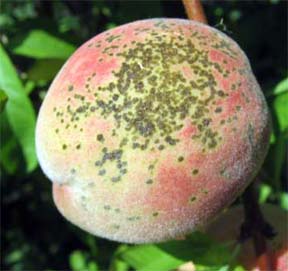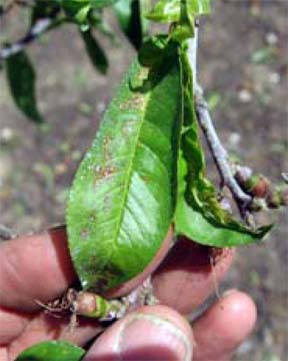Management of bacterial spot on peaches and nectarines
Bacterial spot of peaches and nectarines can be very difficult to manage under ideal conditions for the disease. A comprehensive disease management program can help to bring this problem under control.
Bacterial spot is an important disease of peaches, nectarines, apricots, and plums caused by Xanthomonas campestris pv. pruni. Symptoms of this disease include fruit spots, leaf spots, and twig cankers. Fruit symptoms include pitting, cracking, gumming, and watersoaked tissue, which can make the fruit more susceptible to brown rot, rhizopus, and other fungal infections. Severe leaf spot infections can cause early defoliation. Severe defoliation can result in reduced fruit size, and sunburn and cracking of fruit. Early defoliated trees are reduced in vigor and winter hardiness.
Fruit symptoms of bacterial spot may be confused with peach scab, caused by the fungus Cladosporium carpophyllium, however scab spots are more circular, have a dark brown/greenish, fuzzy appearance, and do not pit the fruit surface, although skin cracking can occur. Scab does not cause leaf symptoms but can cause spots on twigs. Initial fruit spots of bacterial spot may be superficial but develop into craters.
Leaf symptoms of bacterial spot on peaches and nectarines are generally dark, small lesions, often clustered at the leaf tip where water collects during dews and rain. Leaf tissue around lesions can turn yellow.
The pathogen overwinters in dark, gummy branch tips, and diseased twigs. Removal of gummy tissue during spring pruning may help to reduce inoculum levels. Bacterial spot symptoms on leaves generally are not seen until after bloom but onset can occur earlier if conditions are highly favorable. Fruit are very susceptible when exposed after shuck split and the susceptibility goes down after pit hardening in mid- to late June. However, a high amount of leaf infection and warm wet conditions can cause the continuation of fruit infections after pit hardening. A few weeks before harvest, fruit become more susceptible to bacterial spot infection, however, symptoms are more superficial.
Bacterial spot is favored by hot, dewy, wet conditions, and windy, sandy sites. Spread and entry of the bacterial spot pathogen into plants is favored by abrasions and nicks caused by blowing sand, especially common on outside peach rows next to dirt roads. Spraying trees when foliage is wet from rain or dew may help to spread bacterial spot.
Varietal resistance to bacterial spot is well known and important for managing this disease (Table 1). Nectarines are generally more susceptible than peaches. A variety with moderate resistance to bacterial spot may perform adequately in a site sheltered from wind but look terrible in a bacterial spot-prone site. A highly susceptible variety can serve as a source of infection for surrounding, less susceptible varieties. One disease management strategy is to “hide” more susceptible varieties on the inside of orchard blocks with the most resistant varieties on the exposed orchard edges. Another strategy is to establish sod strips between trees and to use gravel or other dust-suppressing methods on nearby dirt roads.
Table 1. Relative bacterial spot rating for peach and nectarine in Michigan.
| Bacterial spot resistance category | Yellow melting flesh peach |
| Excellent | Biscoe, Blazing Star, Candor, Contender, Harrow Beauty, Harrow Diamond, PF1, PF12A, PF24-007, PF27A, Starfire |
| Good | Blaze Prince, Desiree, Encore, Garnet Beauty, Gloria, Glowingstar, John Boy, Messina, PF5B, PF14 Jersey, PF24-007, PF19-007, PF28-007, Redkist, Redstar, Summer Serenade, Victoria, PF 11 Peach, PF9A-007 |
| Moderate | Allstar, Autumn Star, Beaumont, Canadian Harmony, Coral Star, Early Loring, Glenglo, Harbinger, Harrow Dawn, Harrow Fair, Loring, Madison, PF20-007, PF23, PF25, PF15A, PF17, Redhaven, PF23, PF27A, Early Star, Risingstar, PF5D-Big, PF24C Cold Hardy |
| Fair | Bounty, Cresthaven, GaLa, Jerseyqueen |
| Poor | Elberta, Fayette, Flavorcrest, Halehaven, Laurol, Spring Flame, Suncrest |
| Bacterial spot resistance category | Yellow non-melting flesh peach |
| Excellent | |
| Good | Goldnine, Vulcan, Venture, Vinegold, Virgil, Allgold, GoldJim |
| Moderate | Veecling, Catherina |
| Fair | Babygold 5, Babygold 7 |
| Poor | |
| Bacterial spot resistance category | White flesh peach |
| Excellent | |
| Good | Manon, Saturn*, Scarlet Pearl, Southern Pearl |
| Moderate | Blushingstar, Carolina Belle, Raritan Rose Spring Snow, Sugar May |
| Fair | Benedicte, Klondike White, Lady Nancy, White Lady, |
| Poor | Opale, Snow Bride, Snow Beauty, Snow Giant, Snow King, Snow Prince, Snowfire, Yukon King |
*= peen-tao (flat)
| Bacterial spot resistance category | Yellow nectarine |
| Excellent | |
| Good | |
| Moderate | Fantasia, Firebrite, Harblaze, Harflame, Mayfire, Mericrest, PF11 Nectarine, Stark Ovation, Sunbright |
| Fair | Flavortop, Summer Beaut, Sunglo, Redgold, Eastern Glo |
| Poor | June Glo, Honey Royale, Honeyblaze, Honeykist |
| Bacterial spot resistance category | White nectarine |
| Excellent | |
| Good | Emeraude |
| Moderate | Jade |
| Fair | Arctic Sweet, ArcticGlo, Crimson Snow |
| Poor | Scarlet Pearl, Arctic Belle, Arctic Jay, Arctic Gold, Zephyr, Arctic Pride |
Bacterial spot is a difficult disease to control when environmental conditions favor pathogen spread. As with all bacterial plant diseases, there are relatively few bactericide chemicals available for use. Compounds available for use on peach and nectarine for bacterial spot include copper, oxytetracycline (Mycoshield and generic equivalents), and syllit+captan; however, repeated applications are typically necessary for even minimal disease control.
Oxytetracycline is generally considered the most effective compound and the least prone to phytotoxicity problems (damage to plant tissue), but also perhaps most likely to lose effectiveness with the appearance of bacterial strains with resistance. There is some evidence that the hydrochloride form of oxytetracycline (Fireline) is more effective than the calcium form Mycoshield.

Figures 1 and 2. Left, bacterial spot symptoms on fruit. Right, bacterial spot on leaves.

Figure 3. Peach scab (Cladosporium carpophilum) on peach fruit.
Table 2. General program for in-season use of copper for bacterial spot suppression on peaches and nectarines (Modified from summary by David Ritchie, North Carolina State University).
| Stage | Formulated 53%copper (lb/acre)* | Metallic copper (lb/acre) |
| Delayed dormant | 4 to 5 | 2 |
| 7 – 10 day interval | 2 | 1 |
| 1 – 5% bloom | 1 | 0.5 |
| Petal fall | 0.5 | 0.25 |
| Shuck split | 0.25 | 0.125 |
| After shuck split switch to Mycoshield or Syllit + captan | ||

Figure 4. Copper phytotoxicity symptoms on peach leaves.



 Print
Print Email
Email
